
Torigoye: sea cucumber and butterfly.
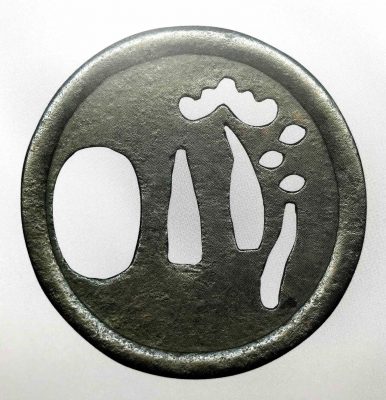
Ko-Katchūshi tsuba: Lake and pine.
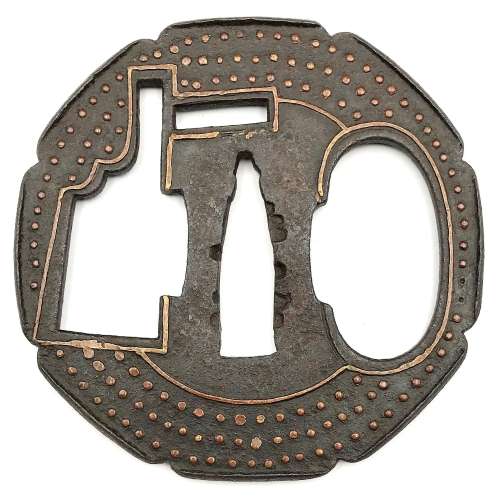

Torigoye: sea cucumber and butterfly.

Ko-Katchūshi tsuba: Lake and pine.
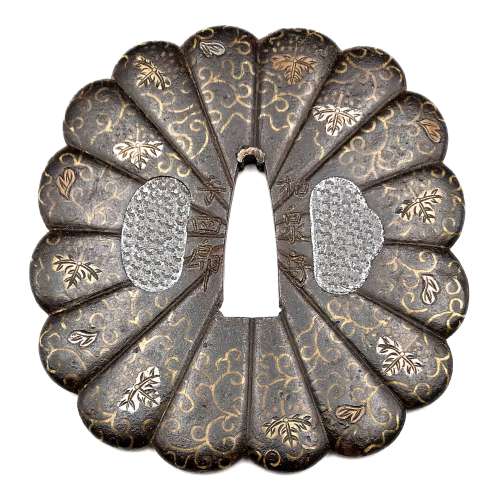
"Early signed example of the work of Koike Naomasa. The kiku shape iron plate is well finished. The flush inlay is brass, for the scroll work on both sides, with the leaves and kiri mon in brass, copper and silver with strong detail carving. Some of the inlay goes almost over the edge, which is goishi gata. The large hitsuana are plugged in lead with starburst kokuin surface design. [...]The face is signed in deep bold kanji: Koike Naomasa; the back is signed: Izumi no Kami, on the right and Yoshiro on the left. There are one or two small pieces of inlay missing. Sold by Sotheby London, Oct. 27, 1981, lot 368. Height = 86 mm, thickness (seppa-dai) = 3.75 mm, (edge) = 4 mm."Another similar example presented at: "Tsuba" by Günter Heckmann, 1995, №T55 — "Designation: Koike Naomasa. Mid Edo, end of the 17th century. Iron, hira-zogan in brass, copper, silver and shakudo, katakiri-bori. Tendrils and leaves. 87.0 x 78.0 x 4.0 mm." Reference: Japanische Schwertzierate by Lumir Jisl, 1967, page. 13. [SV: Actually, his tsuba is signed Izumi no Kami Yoshiro on the back; and Koike Naomasa on the front, exactly as Robert Haynes's tsuba. Dating this tsuba Mid-Edo, 17th century may be considered a misattribution]. More details regarding the Yoshirō tsuba.

Iron tsuba of round form with brown patina decorated with the design of a Buddhist temple bell (tsurigane) in openwork (sukashi), with details outlined in brass wire (sen-zōgan), the outer ring decorated with two rows of brass dots (ten-zōgan), and the bell details carved in sukidashi-bori as on kamakura-bori pieces.
Ōnin school. Unsigned. Late Muromachi period, 16th century. Dimensions: 88.8 x 88.3 x 3.0 mm. As per Merrily Baird, two legends are usually associated with the image of tsurigane, a large, suspended Buddhist bell: one is that of Dojo Temple (Dojo-ji), and the other is of Benkei stealing the tsurigane of Miidera Temple. Interestingly, this type of bell (tsurigane) is not described as a family crest (mon), while suzu and hansho bells are.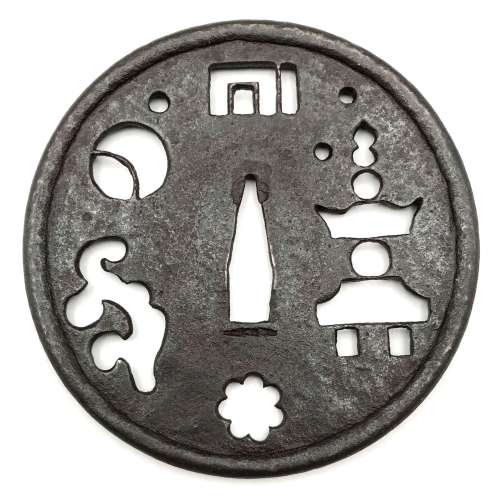
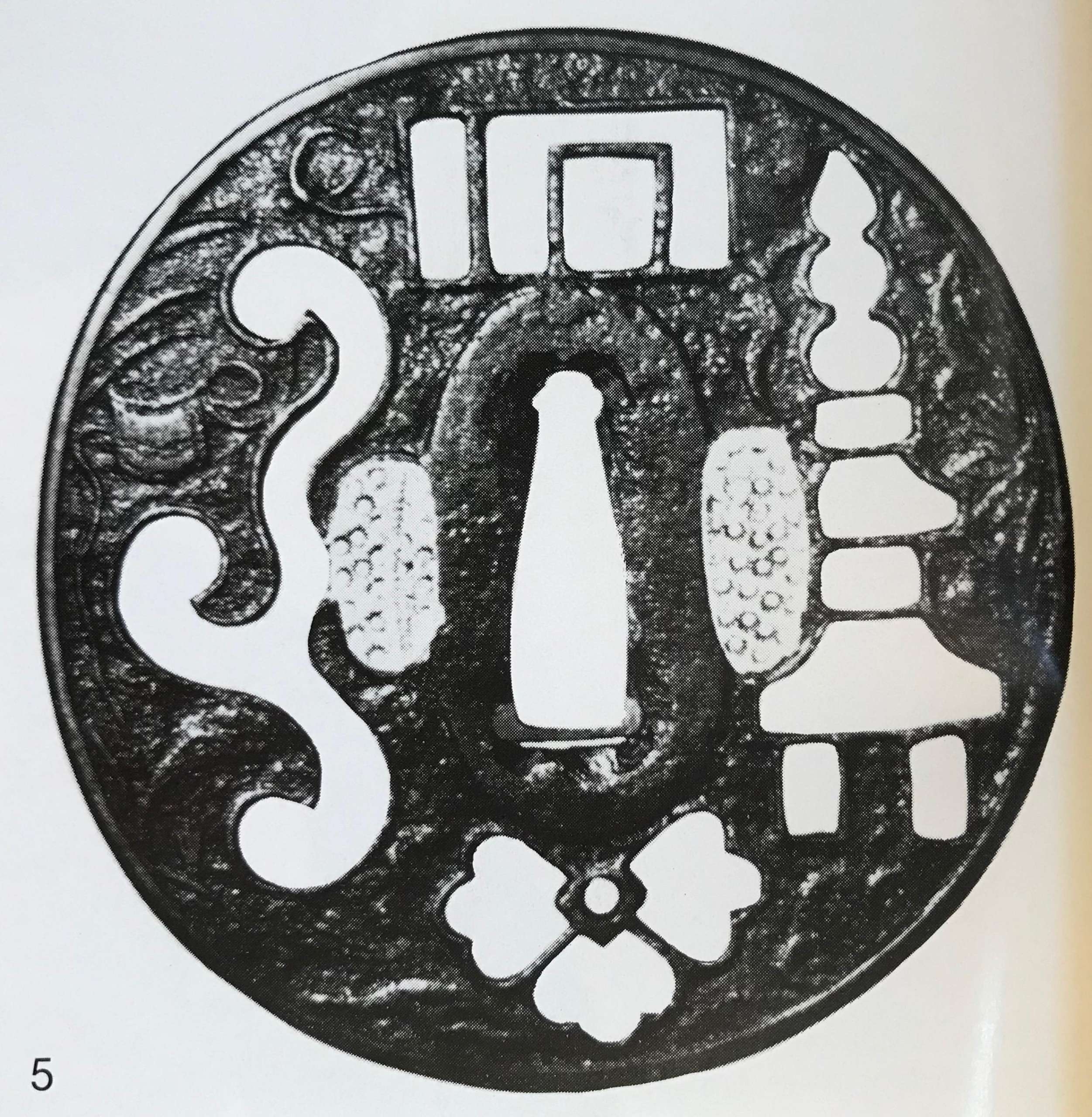
100 selected tsuba from European collections. Catalogue by Robert Haynes and Robert Burawoy, 1984, page 16, №5.
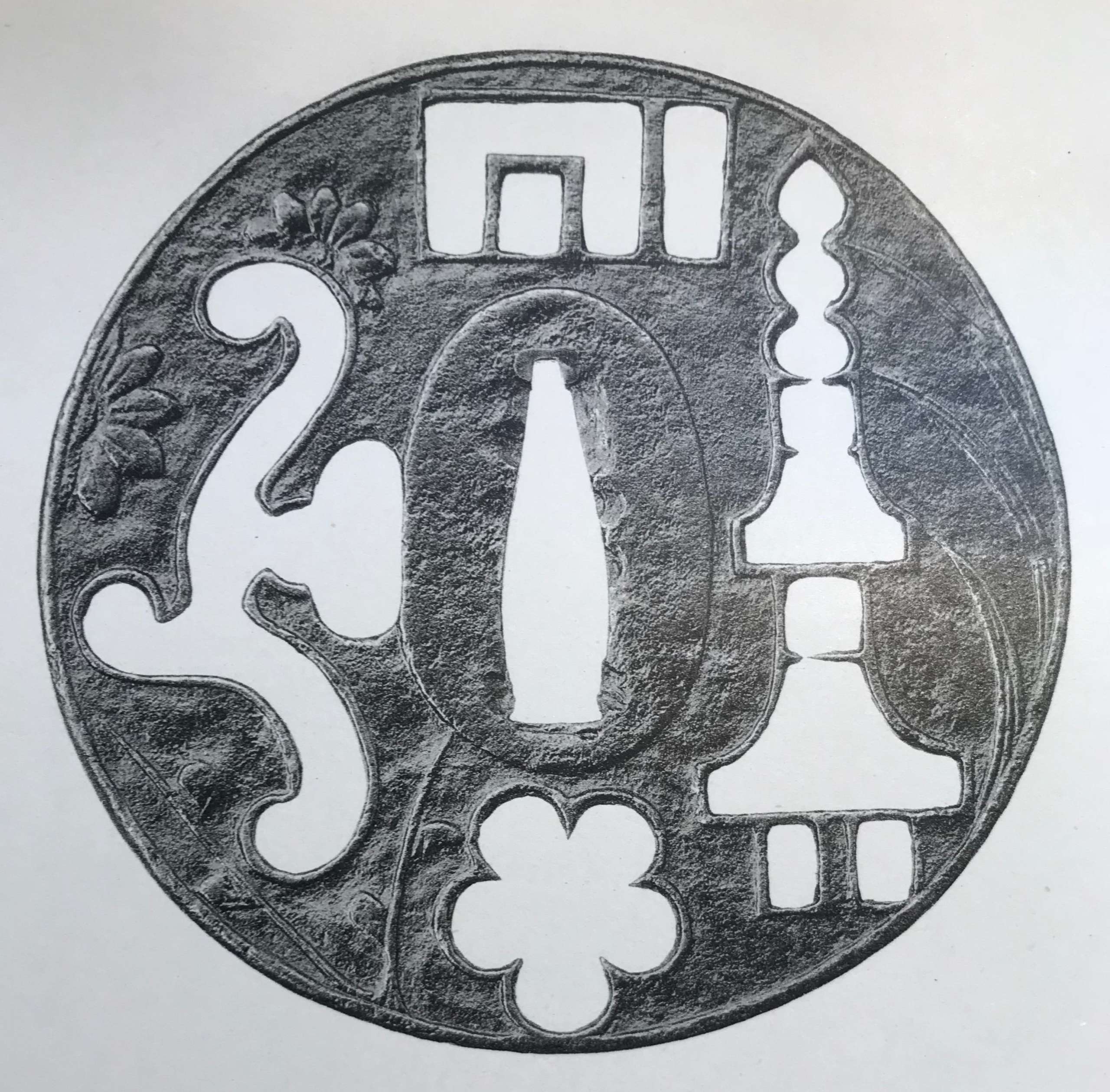
Japanese Sword Fittings. Collection of G.H. Naunton, Esq., by Henri L. Joly, - 1912; №9.
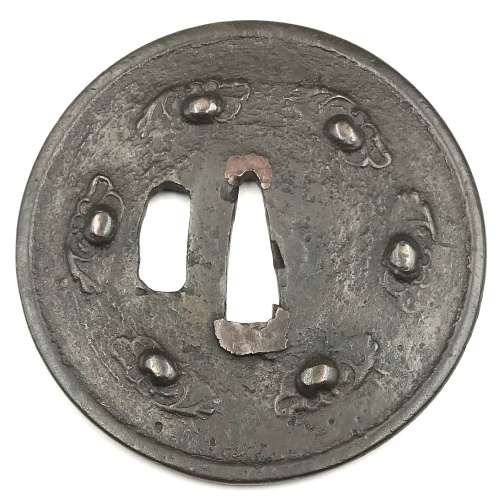
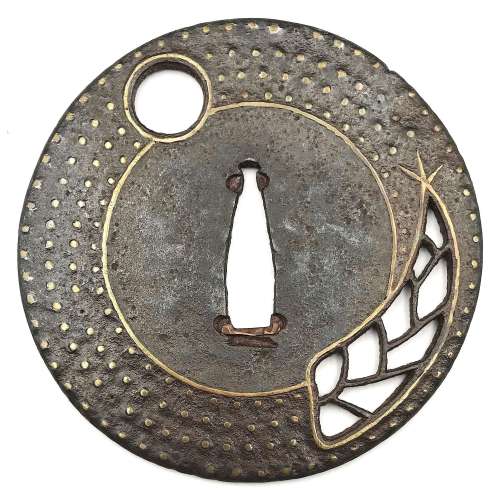
Tears That Brought Bamboo-shoots From the Frozen Earth: Meng Zong Meng Zong lived during the Three Kingdoms Period of China's past. His father died when he was young, and he and his mother struggled to survive. One winter his mother was stricken with a serious illness, and craved some bamboo-shoot broth as medicine. But in the depths of winter, with snow and ice blanketing the ground, where was anyone to find fresh bamboo shoots, shoots that emerge only in the warm months? Nonetheless, Meng Zong, to avoid disappointing his mother, bravely fetched his shovel and went out into the white landscape in search of bamboo shoots. In the thicket he found only frosted leaves and green stalks coated with snowflakes and ice. Look as he might, there were simply no fresh shoots growing in the winter. The thought of his poor mother lying sick on her bed, waiting for bamboo-broth medicine, made his heartache. Uncontrollably, tears began to fall in rivers to the ground beneath the tall, emerald canes. Even now, as his tears flowed down, he kept a light of faith in his heart. If he was truly sincere in his search, perhaps.... Just then Meng Zong nearly tripped and fell over a sharply protruding lump of earth. He quickly knelt down and knocked aside the dirt with his trembling fingers. How uncanny! Underneath his frozen hands he discovered a bed of fresh, tender bamboo shoots! Overjoyed, he gathered up a coatful and carried them back home. The broth that he quickly set stewing in the pot soon cured his mother's illness. The neighbors, hearing the story, exclaimed that it was the strength of his sincere, unselfish, filial resolve that inspired heaven and earth to respond, and to bring up, out of season, the fresh shoots that cured his mother's disease. Before Meng Zong's prayers generated this miracle, it was normally considered impossible for bamboo shoots to grow in the winter. After the nmiracle took place, however, people were able to gather and to eat bamboo shoots all year round. The winter variety that existed hereafter became known as "winter shoots." The villagers were deeply influenced by Meng Zong's courage and devotion. They renamed the spot where the event took place, "Meng Zong's Bamboo Grove". We can now enjoy bamboo sprouts during the winter as well, and as we do so, it is fitting to recollect Meng Zong's outstanding example of filial respect, and reflect on our conduct as sons and daughter of our parents. A verse in his honor says, His teardrops transformed winter at the roots; Up from the ice crept tender bamboo shoots. Instantly, the winter-sprouts matured; Heaven's will: a happy, peaceful world.




Compton's Collection, Part I, p. 11, №3.
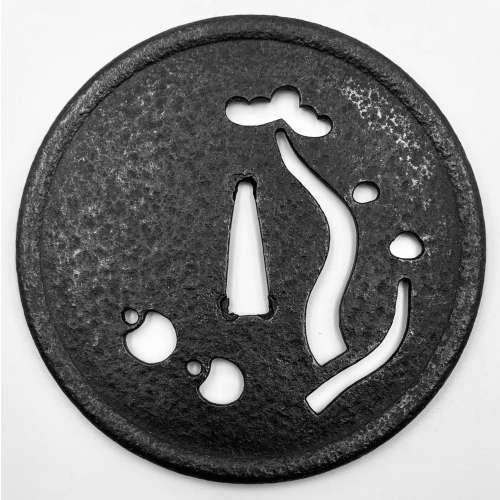
Iron tsuba of circular form with design of pine trees (matsu) and monkey toys (kukurizaru) in openwork (ko-sukashi). Ko-Katchushi school.
Raised rim (mimi) with iron bones (tekkotsu). Size: Diameter: 99.5 mm; Thickness: 2.1 mm at centre; 4.3 mm at the rim.Early Muromachi period: 15th century (Kakitsu - Bun'an era, 1441 - 1449).

 The same interpretation of the said heart-like symbol (aoi leaf) is given at Helen C. Gunsaulus. Japanese sword-mounts in the collection of Field Museum. // Publication 216, Anthropological Series, Volume XVI; Chicago, 1923; p. 54: "This mokkō-formed tsuba recalls the aoi form, perforated as it is with the four aoi leaves." It is possible that the "wild boar's eye" theory was developed by later scholars.
The same interpretation of the said heart-like symbol (aoi leaf) is given at Helen C. Gunsaulus. Japanese sword-mounts in the collection of Field Museum. // Publication 216, Anthropological Series, Volume XVI; Chicago, 1923; p. 54: "This mokkō-formed tsuba recalls the aoi form, perforated as it is with the four aoi leaves." It is possible that the "wild boar's eye" theory was developed by later scholars.
 There is also a theory, supported by Graham Gemmell, saying that: “In simple terms Onin works are decorated Ko-Katchushi tsuba. … But, not content with iron alone, they began to decorate it with what was, in the early Muromachi period, a rare and valuable metal, brass. The Onin workers cut the design into the iron, using narrow channels, cast the brass, piece by piece, and then hammered it into the iron plate as though they were putting together a jigsaw. When complete the tsuba would be black lacquered exactly as the plain iron ones had been, the brass shining dully through it in a way that fulfilled the goal of shibui or restrained elegance.” [Tosogu. Treasure of the samurai. Fine Japanese Sword Fittings from The Muromachi to The Meiji Period, by Graham Gemmell. // Sarzi-Amadè Limited, London, 1991. An exhibition held in London from 21st March to 4th April, 1991]. The following illustration from Helen C. Gunsaulus. Japanese sword-mounts in the collection of Field Museum. // Publication 216, Anthropological Series, Volume XVI; Chicago, 1923; pp. 43 supports the idea.
There is also a theory, supported by Graham Gemmell, saying that: “In simple terms Onin works are decorated Ko-Katchushi tsuba. … But, not content with iron alone, they began to decorate it with what was, in the early Muromachi period, a rare and valuable metal, brass. The Onin workers cut the design into the iron, using narrow channels, cast the brass, piece by piece, and then hammered it into the iron plate as though they were putting together a jigsaw. When complete the tsuba would be black lacquered exactly as the plain iron ones had been, the brass shining dully through it in a way that fulfilled the goal of shibui or restrained elegance.” [Tosogu. Treasure of the samurai. Fine Japanese Sword Fittings from The Muromachi to The Meiji Period, by Graham Gemmell. // Sarzi-Amadè Limited, London, 1991. An exhibition held in London from 21st March to 4th April, 1991]. The following illustration from Helen C. Gunsaulus. Japanese sword-mounts in the collection of Field Museum. // Publication 216, Anthropological Series, Volume XVI; Chicago, 1923; pp. 43 supports the idea.
 Helen C. Gunsaulus' description of the dragonfly emblem is as follows: "This motive, the dragon-fly (akitsu), is generally accepted as a symbol of the kingdom of Japan, and the origin of the idea is traced to the legend recounted in the Kojiki and Nihongo of the Emperor Jimmu's view of the island from mountain top. He is said to have thought the kingdom looked like a dragon-fly touching its tail with its mouth. From this it received its name Akitsu-shima... etc."
Helen C. Gunsaulus' description of the dragonfly emblem is as follows: "This motive, the dragon-fly (akitsu), is generally accepted as a symbol of the kingdom of Japan, and the origin of the idea is traced to the legend recounted in the Kojiki and Nihongo of the Emperor Jimmu's view of the island from mountain top. He is said to have thought the kingdom looked like a dragon-fly touching its tail with its mouth. From this it received its name Akitsu-shima... etc."
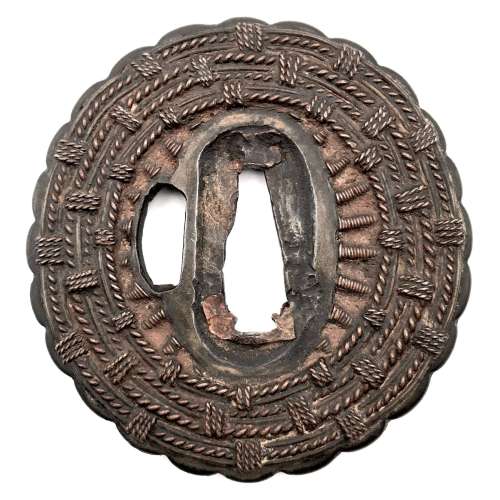

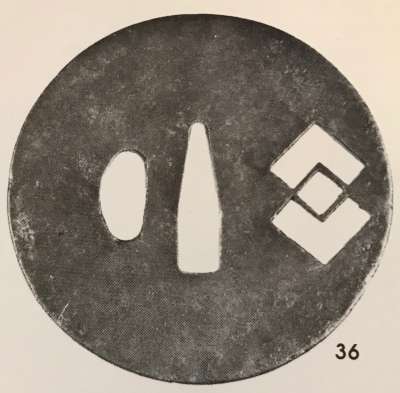
Robert E. Haynes Catalog of April 9-11, 1982, № 36.


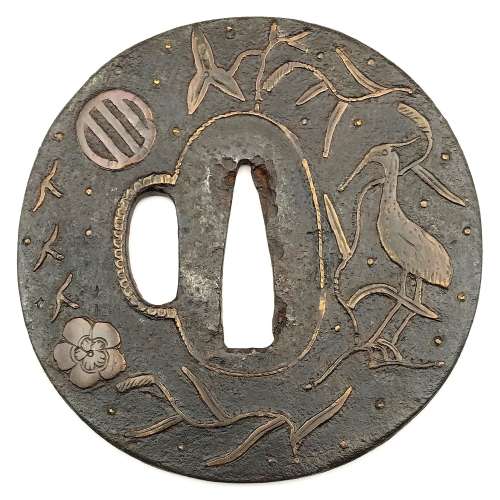
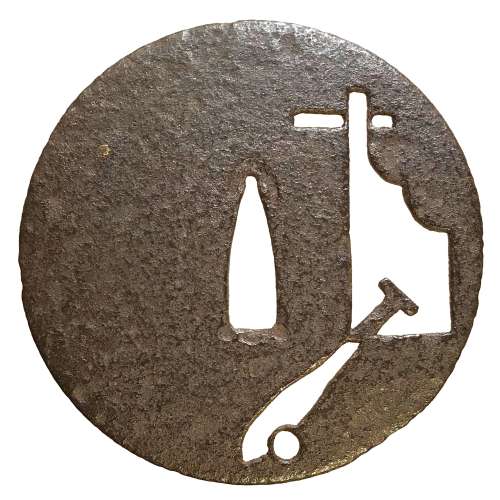
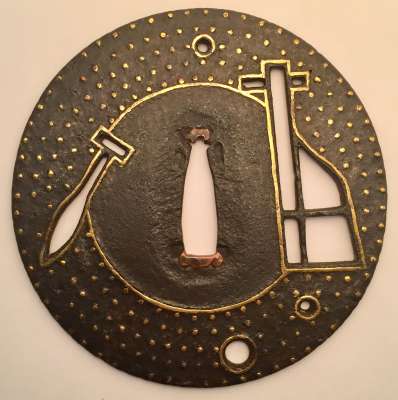


Varshavsky Collection: TSU-0345.2018

Compton Collection, part II, pp. 14-15, №17: Kamakura-bori tsuba, ca. 1450.
